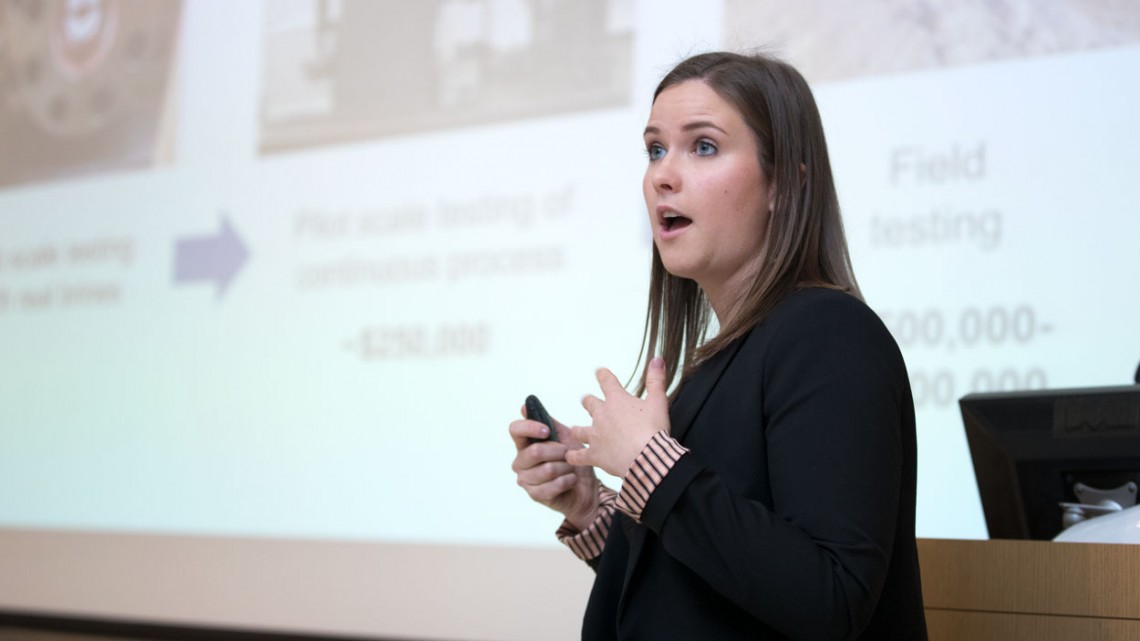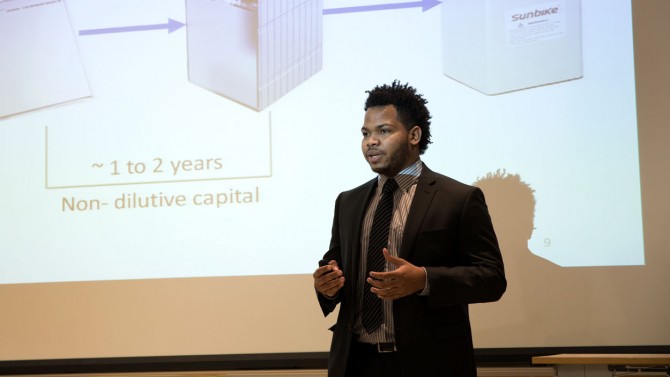
Commercialization fellow Arna Pálsdóttir discusses her work on supercritical fluid extraction of lithium.
Commercialization fellows present new technologies
By Teagan Todd
Doctoral students in Cornell’s Commercialization Fellows program gathered on Dec. 8 in the Physical Sciences Building to present their work and future plans for their projects.
Offered by the College of Engineering, the Commercialization Fellowship provides six months of funding for engineering Ph.D.s to teach them how to explore potential industrial applications of university inventions. The fellows work with entrepreneurship faculty in the SC Johnson College of Business to identify market opportunities for their technologies.
Integrating commercialization skills into their doctoral studies in engineering, Commercialization Fellows are paired with MBA students in the Samuel Curtis Johnson Graduate School of Management. The fellows prepared 5-minute presentations on the status of their technologies and where they believe those technologies are headed.
Fifth-year doctoral candidate Catherine Wong has been working on how to make robots more efficient and effective through the use of what she called a “rapid-prototyping toolkit for robot controllers.” Wong talked to potential customers to determine whether or not her technology was a market fit.
Mechanical engineering fellow Hugh Bullen’s work protects anodes for rechargeable batteries, which results in better-performing batteries. Bullen has also been studying the potential market need for high-capacity lithium batteries. He said the most apparent customer for his product would be the commercial drone industry, because lightweight, high-capacity batteries would allow drones performing tasks such as power line inspection to fly for longer periods without interruption and battery swaps.
Arna Pálsdóttir’s research focuses on supercritical fluid extraction of lithium. “I work to improve lithium extraction technologies, helping the lithium mining process become more efficient. Lithium is an important clean energy source, which could make transportation systems worldwide more environmentally friendly,” Pálsdóttir said. Like Wong, she also had to get comfortable leaving the lab and talking to customers, but the work led to a better understanding of the market application and the path toward commercialization of the technology.
Speaking about her work with electron microscopy pixel array detectors, Kayla Nguyen asked the audience to imagine taking a picture of themselves with the sun in the background. With the electron microscopy imaging she has been working on, Nguyen said one would be able to clearly see themselves, the sun and its sunspots without saturating the camera.
“Now we can look into the complexity of life itself,” Nguyen said, referring to the technology’s potential use in the biological imaging market. She emphasized that imaging on this level allows for a great deal more information communicated in each photo.
Biological and environmental engineering fellow Juan Guzman discussed his “WheyAway 5000” or Capro-X bioprocess project. The project focuses on developing a method to turn acid whey, a byproduct of Greek yogurt production, into bio-oil that can be sold at market as a livestock feed supplement.
Guzman said he has discovered a business model where his company will make money in two ways: Waste reduction – currently solved with expensive trucking and water treatment, yogurt producers will pay for the transformation of acid whey into bio-oil – and by selling bio-oil to other companies.
In a prerecorded presentation, doctoral candidate Thomas Wallin discussed how the technology from professor Robert Shepherd’s lab allows 3-D printers to print a silicone-like material, which could be of interest to industries such as those involved in the production of medical prosthetics.
David Erickson, associate dean for research and graduate studies in engineering, closed the presentations by remarking that the hands-on approach of the program has resulted in greater business and research opportunities for its fellows.
Teagan Todd '20 is a writer intern for the Cornell Chronicle.
Media Contact
Get Cornell news delivered right to your inbox.
Subscribe